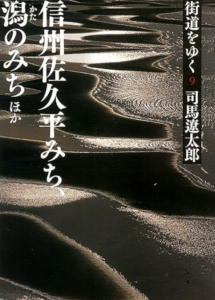Life Tips & Miscellaneous Travel and History Zen Philosophy and History Art and Sport Navigation of this blog
Summary
Travel is an act for human beings to visit new places and experience different cultures and histories. Through travel, people can actually feel historical events and people’s lives by visiting historical places and cultural heritage sites, and can gain a deeper understanding of history and broaden their own perspectives. In this section, we will discuss the historical background of the trip and the places visited based on Ryotaro Shiba‘s “Kaido yuku” (On the Road) about this journey and history.

Kaidou wo yuku Volume 9 Kata no michi.
The previous trip was to Sendai and Ishinomaki.This time, it will be a journey to Niigata Prefecture and the Lagoon Road. Intrigued by the history of people who were not blessed with suitable land for cultivation but struggled to expand their fields, Ryotaro Shiba visited the low marshy areas of Niigata. First, he visited Kameda-go, which was formed on the sandbank between the Shinano and Agano Rivers, and then crossed the Agano River to visit Toyoei City (present Niigata City).
This trip will be to Niigata. Niigata is located in the center of Honshu, on the Sea of Japan side, and is home to Sado Island, which was mentioned in “Kaido yuku Sado no Michi” (The Road to Sado Island). As described in “Kaido Yuku: The Northern Highway, Its Side Routes, and the Mysteries of Ancient Japan” before the 19th century, marine transportation was the mainstream, especially the Northern Frontier Route on the Sea of Japan side, which was safer and cheaper than the Pacific Ocean route. As mentioned in the article “The Side Routes and the Mysteries of Ancient Japan”, before the 19th century, maritime transportation was the mainstay of the region, especially along the Northern Frontier Route, which was safer and less expensive than the Pacific Ocean route.
This trend has continued since the Meiji Era, as the Pacific Belt region developed through industrialization and the development of Hokkaido became more active, leading to an outflow of population from the Sea of Japan side, including Niigata, to the Pacific coast or Hokkaido.
Historically, the power of the Yamato regime extended to the area, as described in “Kaido yuku – Sendai/Ishinomaki“, and a defensive building called “Nuutarinoki” was built in 3 Taika Era to protect the area from Emishi, who ruled the northern part of the country. In the Muromachi period (1336-1573), the Uesugi clan became the guardian, and the Nagao clan replaced the Uesugi clan as the guardian and held power at Kasuga-yama Castle.

Emerging from this Nagao clan was the famous warlord Nagao Kagetora (who later inherited the Uesugi family and became Uesugi Kenshin).

Uesugi Kenshin, known as the “Dragon of Echigo,” fought 12 fierce battles with Takeda Shingen in the neighboring Kai province (Battle of Kawanakajima), and is said to have been the only one feared by Oda Nobunaga, who was growing in power at the time.
Kenshin was also a deep believer in Buddhism, fostered a heart of righteousness, and extended a helping hand to those who asked for it, as typified by the famous phrase “send salt to the enemy” (Kenshin sent salt instead of participating in the sanction to stop salt export to Shingen in Kai where there was no sea: an old expression used to describe saving an enemy in a difficult situation without taking advantage of his weakness). He was also a righteous warlord, as typified by the phrase “Kenshin did not take advantage of the weakness of an enemy in a difficult situation, but instead saved him.
Incidentally, Kyohei Shibata played Uesugi Kenshin in NHK’s 1988 historical drama “Takeda Shingen,” and the scene in which he holed himself up in a temple because he was fed up with the ongoing land disputes among his men, which were common during the Warring States period, still remains in my memory.

After Kenshin’s death, his successor, Uesugi Kagakatsu, who is also mentioned in “Hashu Kaido – Yamagata no Michi“, was forced to move from Echigo to Yamagata/Yonezawa, which is nothing but irony, as his power was greatly reduced by a succession battle between his brothers, which Kenshin hated the most.
After this, the Nagaoka, Shinobata, and Murakami clans were established in the Edo period, and during the Boshin War at the end of the Edo period, Ryotaro Shiba wrote the historical novel “Touge” featuring Tsugunosuke Kawai, a retainer of the Nagaoka clan.
The novel is also being made into a movie in 2022 as “The Last Samurai of the Pass“, which can be seen on Hulu and Amazon Prime.

The name of Niigata is derived from “new lagoon. The lagoon here refers to a shallow beach that is hidden at high tide and appears when the tide recedes, as well as a swampy area. Ryotaro Shiba and others visited Kametago, the center of the project.
Until about 1945, Kameda-go was said to have been a deep rice field with water so deep that if a child stood in the rice field, water would come into his or her mouth.

The government invested a huge sum of money to convert the fields to dry rice paddies. It was not until 1948, when the Kurinoki Drainage Pump Station was built, that the shift to dry rice paddies was quickly made,

The water in Kameda Township was discharged into the Shinano River by pumps at a drainage pumping station, and the land finally dried up significantly in the late 1950s, and the area became the center of Niigata City, where “DENKA Big Swan Stadium”, the home stadium of Albirex Niigata, and Niigata Municipal Hospital are now being built one after another.




コメント